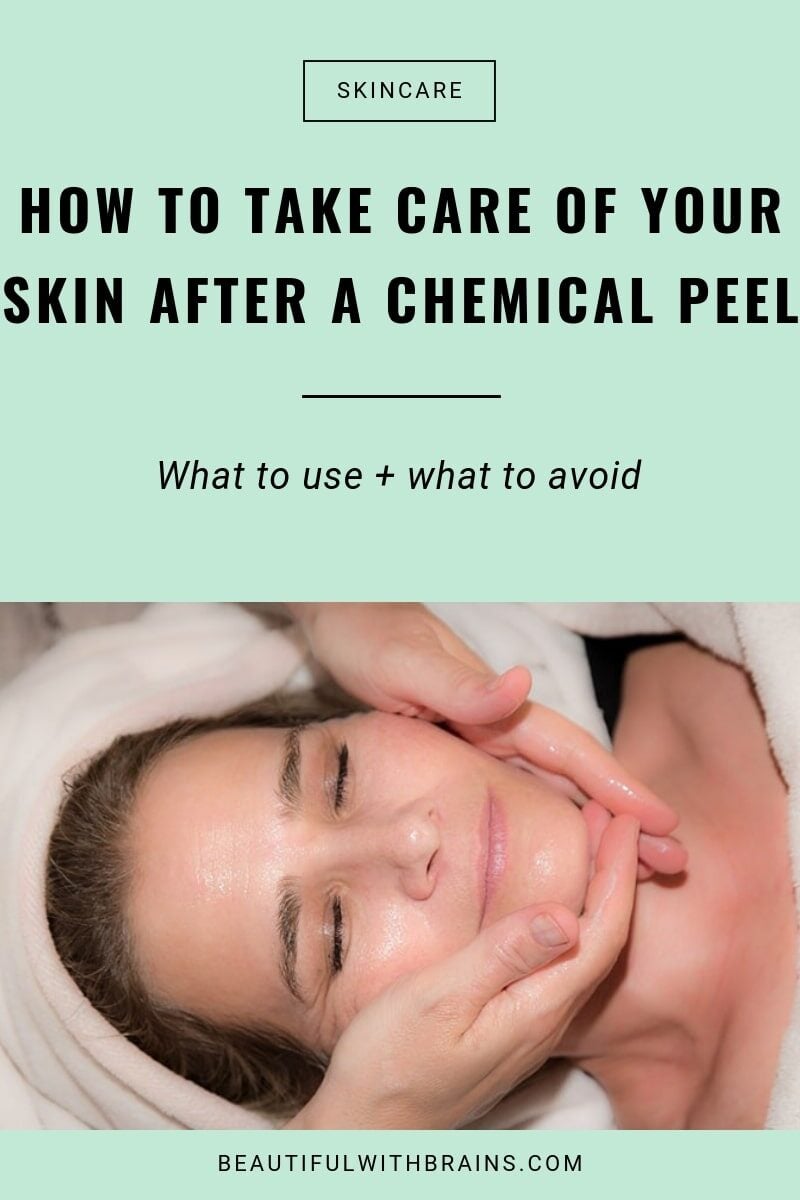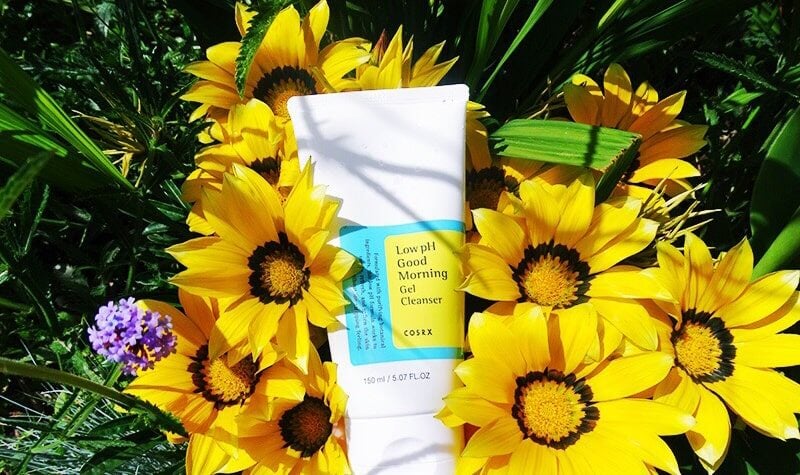
Thinking about getting a chemical peel?
I’m a huge fan. Chemical peels are the quickest way to get a glowier complexion and erase the pesky wrinkles and dark spots that give your real age away.
But they’re not without side effects. A chemical peel – even when done right – can leave your skin irritated, red, and peeling for a few days afterwards.
Forget your usual skincare routine. Post peel skin is too delicate for retinol & co. So, what are you supposed to do instead?
I’ve got you covered. Here’s how to take care of your skin after a chemical peel to speed up the natural healing process without compromising its results:
What Is A Chemical Peel & Why Should You Get One?
A chemical peel is a skincare treatment that uses acid solutions – such as AHAs (alpha hydroxy acid), BHAs (beta hydroxy acid), and TCA (trichloroacetic acid) – to remove the damaged top layers of dead skin cells.
Once they’re off your skin, you uncover the newer, brighter cells that were hiding underneath. Put simply, you’re helping your skin exfoliate faster.
Here’s how a chemical peels helps skin:
- It improves your skin’s texture, making it softer and smoother
- It helps reduce the appearance of fine lines and wrinkles
- It fades away dark spots and hyperpigmentation
- It helps minimise acne scars and other imperfections
- It brightens your complexion and give it a healthy glow
- It helps treat acne and decongest pores (BHA peels)
FYI, peels come in three level of intensity: low, medium and high. The higher the intensity, the worse the side effects.
Most people never need high level chemical peels. The lower intensity peels are more than enough to help fade away the signs of aging and smaller imperfections.
Just don’t overdo them. In your 20s and 30s, two or three peels a year is all you need. Once you reach the big 4-0, you can go a bit more often (six/eight times a year).
P.S. Some chemical peels use retinol instead of acids. Everything in this post applies to this type of peel, too.
Related: TCA Peel VS Glycolic Acid Peel: Which One Is Better For You?

How To Take Care Of Your Skin After A Chemical Peel
So, you’ve decided it’s time to have your first chemical peel? Here’s all you need to know about chemical peel after care:
1. Wear Sunscreen Religiously
I know you’re already doing this, RIGHT? If not, this is the time to get serious about sun protection.
Here’s why: dead skin cells are there for a reason. They help protect your skin from its enemies, including UV rays. Now the peel has melted them away, your skin is MORE prone to sun damage.
You didn’t just pay a small fortune for a peel to see your dark spots come back with a vengeance within a few months, right? Slather on that sunscreen first thing in the morning and reapply it as necessary.
Even if it’s cloudy. Or rainy. Or you’re staying inside. Or just driving your car and running errands. UV rays are sneaky. They can penetrate through clouds and windows and even be reflected on snow. Don’t risk it!
P.S. I usually recommend a spray sunscreen for touchups during the day. Not in this case. A lot of spray sunscreens are loaded with alcohol – that’s too irritating for you now. If you really can’t reapply your morning sunscreen, use a powder with SPF and dust it on generously.
P.P.S. While you’re at it, try to spend as little time as possible in the sun. You don’t have to become a recluse. But this ain’t the right time to go on a beach holiday. Know what I’m saying?
Best Picks:
- EltaMD UV Pure Broad-Spectrum SPF 47 ($25.00): available at Dermstore and Walmart
- Shiseido Ultimate Sun Protection SPF 50 Sunscreen + WetForce For Sensitive Skin & Children ($42.00):available at Nordstrom and Ulta
- Skinceuticals Physical Fusion UV Defense SPF 50 ($34.00): available at Blue Mercury and Dermstore
Related: How To Reapply Sunscreen Without Ruining Your Makeup

2. Go Back To Basics With Your Skincare Routine
Forget about retinol, vitamin C or exfoliation (your skin’s got too much of that already!). After a chemical peel, keep your skincare routine as simple and gentle as possible. Here’s what you need:
- Gentle cleanser: In the morning, wash your face with a gentle, low pH foaming or milk cleanser. They remove all traces of dirt without drying out your skin. In the evening, you can use the same cleanser or opt for an oil-based makeup remover. Just make sure it doesn’t contain any essential oils or other irritants.
- Moisturizer: Your skin is drier now, so make sure you moisturize it well morning and evening. I usually turn to French skincare brands for this step. Their moisturisers are very basic but sooooo soothing! Just what the doctor ordered.
- Sunscreen: This is the most important part of your after peel skincare routine, which is why it deserved its own section. Don’t skip it!
- Antioxidant serum: I usually skip this step, but if you want to maximize your anti aging routine, you can add an antioxidant serum to the mix. Antioxidants destroy free radicals before they have a chance to give you wrinkles and dark spots. Just stay away from anything with L-Ascorbic Acid, retinol or other powerful antioxidants that can sting your skin. If it tingled before the peel, don’t use it after!
That’s it! You don’t really need anything else during the recovery period. How long does that last?
It depends on the intensity of the peel you had. I tend to go for low and medium peels, so I usually follow this minimalistic skincare routine for a week afterwards.
Best Cleansing Picks:
- CeraVe Hydrating Facial Cleanser ($14.99): available at Dermstore, Feel Unique, Ulta and Walmart
- Corsx low PH Good Morning Gel Cleanser ($11.00): ph 5.5. Available at Sokoglam and YesStyle.
- La Roche Posay Toleriane Dermo Cleanser (£8.75): available at Dermstore and Feel Unique
Best Moisturizing Picks:
- Bioderma Sensibio AR ($24.90): available at Dermstore, Escentual and Feel Unique
- CeraVe Facial Moisturizing Lotion PM ($15.99): available at Dermstore and Ulta
- La Roche Posay Toleriane Ultra Cream ($29.99): available at Dermstore, Escentual, Feel Unique and Ulta
Related: Why You Should Stick To Low pH Cleansers
3. Treat Your Skin Gently
I can’t stress this enough. Your skin is super sensitive now. You have to treat it with kid gloves and avoid anything that could even remotely irritate it, including:
- Clarisonic, Foreo and other sonic cleansers
- Essential oils
- Exfoliating acids and scrubs
- Fragrance
- L-Ascorbic Acid
- Microdermabrasion/microneedling at-home devices
- Vitamin A (retinol, tretinoin etc)
- Vigorous rubbing (pat your skincare on, instead)
Want you check your skincare products don’t contain any irritants? Click on the image below to subscribe to my newsletter and receive the “Irritating Ingredients Cheat Sheet” with the most irritating ingredients lurking in your cosmetics:
Related: Pat or Rub: What’s The Best Way To Apply Your Skincare Products?
Don’t Pick At Your Flaky Skin!
I get it. Seeing those flaky bits of skin is annoying. How can you leave the house when you look like your skin is coming off?!
Newsflash: your skin IS coming off. That’s why you had the peel in the first place, remember?
The worst thing you can do right now is pick off those flakes. Your skin is gonna shed on its own. Forcing the process will only result in unwanted scarring and dark spots.
No exfoliation either. Your skin is already exfoliating on its own. Using your Clarisonic, a glycolic acid toner or even a washcloth to speed up the process only irritates skin and slows down the recovery process.
Related: Should You Use A Washcloth To Cleanse Your Skin?
The Bottom Line
After a chemical peel, your skin is red, flaky and easily irritated. Stick to a basic, gentle skincare routine that speeds up the healing process and pile on your sunscreen. Whatever you do, don’t pick at your skin!


Hi, just wondering what other treatments you’ve had that you would recommend?
Bree, it really depends on what you’re trying to achieve. Atm, I’m very much into lasers. Instead, I don’t care much for micro needling and microdermabrasion.
Hi Gio,
I love your blog. Just curious why do you prefer laser treatments over microneedling?
Kim, I’m not a fan of anything that injures skin.